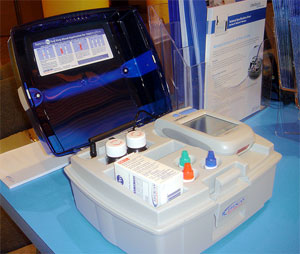
Lantronix has scored their biggest medical device deal to date, "a custom, battery-operated version of its commercially-available WiBox® 802.11 b/g wireless device server for the manufacturers medical point-of-care application." (press release)
quantity purchase commitment valued at approximately $360,000 over the
initial 12 months of production and an additional minimum commitment
for approximately $490,000 of next-generation technology based on
certain project milestones.
The WiBox takes a serial output and converts it to a wireless network connection. Johnson & Johnson's OneTouch was the first point of care glucometer with wireless capabilities, using a terminal server and 802.11 radio from Lantronix. This is a good product strategy for legacy devices - if you're doing some sustaining engineering or refreshing an existing device, adding an external radio module is your only choice for wireless connectivity.
The problem with this approach for a new product is that it transforms a nice hand held device into a luggable package the size of a makeup case. While a "quick and dirty" solution for device vendors, external radios represent problems for customers. External modules get damaged and lost, and the additional connections between the device and external radio represent new points of failure. Trouble shooting deployed connectivity solutions represents a significant hidden cost for health care providers, and bolt on solutions like this one only contribute to the problem.
The good news is workflow. Connectivity is all about workflow - the process steps required to complete the tasks that surround the connected medical device - and wireless is a big improvement over forcing nurses back to a certain location to dock a device to download data. Perhaps the biggest workflow weakness with add-on radios is establishing patient context.
The apparent move among point of care diagnostics vendors from batch connectivity via docking stations to wireless connectivity is also an example of the incremental approach that many device vendors take with connectivity. As I'm fond of saying, you don't know what you don't know, and it is all too easy to take that first obvious ideal - "hey, sure, nurses can just take the device back to the recharger/docking station to download data!" - and after the fact realize that customers think it sucks don't like it. The next obvious step for point of care diagnostics vendors is wireless, but there are inherent problems here too. Then it will be something else.
Part of the problem is as that vendors look to customers for the solution ("what do you want?") rather than requirements. Point of care diagnostics are relatively new for customers, and connectivity is certainly very new - at best customers can tell you what they don't like about your competitor's connectivity solution, and can't describe the optimal solution because vendors have yet to build it.
The end result is an expensive and frustrating experience for customers and vendors both, where imperfect incremental solutions are bought and rejected over several years. After a thorough needs assessment and vendor selection process (that's focused more on the workflow than anything else) buyers should insist on trial installations for final evaluation and acceptance.
Vendors should consider taking a longer term view of connectivity to minimize or eliminate these incremental solutions - you'll spend a little more up front, but you'll save a lot in the end. The vendor pay-off for doing connectivity right is the competitive advantage of a superior solution. Similar concepts apply to the software side of connectivity solutions - the data management, remote access, HL7 interface, etc. Fortunately, new approaches can greatly reduce time to market and development cost for connectivity and related software - if you know what you're doing...
Thanks to Mark H. for the tip. Pictured right is the OneTouch wireless glucometer. You can just see the Lantronix module's antenna at the back of the case against the lid.


Trackbacks/Pingbacks